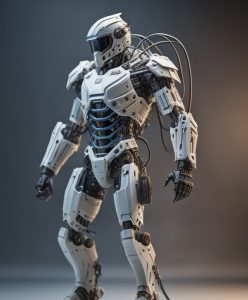
TOP 5 EXOSKELETONS FOR REHABILITATION
Increasingly, medical professionals are using different types of exoskeletons in physiotherapy after complex injuries, strokes, and congenital diseases. In this article, we’ll take a look at 5 of the most popular and effective ones.
- Exoskeleton Walking Assist Device. This device, developed in Japan by Honda, is designed for walking and is worn by fastening numerous straps around the legs or waist. With the help of the device, the patient can walk, climb stairs or inclined planes, and squat. The “skeleton” helps the wearer maintain balance by directing its force so that it passes through the center of gravity of the person, following his or her movements. The device takes into account different human postures when adjusting the force. The main data of the exoskeleton include: weight – 6.5 kg, operating time – 2 hours (1 charge). In physical rehabilitation, this exoskeleton can be used by victims with injuries to the lower extremities or spinal column.
The Indego exoskeleton
was developed by Parker Hannifin at Vanderbilt University (USA). It allows you to move the joints of the hips and knees. The device works as follows: the upper part fits snugly to the torso; supportive elements made of durable material wrap the legs from the hip to the knee and from the knee to the calves; the joints at the hip and knee start working with the help of a microcomputer and electric motors powered by batteries. The “skeleton” is easy to operate: to start walking, a person needs to lean forward a little, to sit down, lean back and stay like that for a few seconds. One of the most important features of this device is that it can be used when the patient is completely paralyzed, in which case the “skeleton” does all the work, as it is the only robot that can be dressed. It contains FES (functional electrical stimulation technology), which delivers weak electrical impulses to paralyzed muscles. Under the influence of FES, muscles tense and relax.
Kickstart exoskeleton
. The peculiarity of this device is that it is mechanical and uses the kinetic energy generated by a person while walking. Natural springs capture kinetic energy and release it, so the hip muscles flex and extend. The device is designed to be worn over a person’s clothing and consists of a waist belt, two support structures, and conventional modeled insoles to secure the device to the foot. The exoskeleton is intended for use by patients with weak limbs, neurological injuries or stroke.
The rehabilitation exoskeleton REX,
belongs to Rex Bionics, a company based in New Zealand. This is an innovative motorized exoskeleton suit. People with lower limb paralysis, which was acquired after spinal cord injuries due to unsuccessful surgeries or spinal cord injuries, can be upright and perform certain movements. This suit is ideal for rehabilitation procedures in medical institutions, at home and at work. The principle of operation of the device is to increase the strength and speed of the patient’s muscles, while he does not need additional stabilization devices, his hands remain completely free.- Robotic exoskeleton for shoulder rehabilitation. The development belongs to the Center for Robotics and Automation (CAR, UPM-CSIC), located in sunny Spain, and contributes to more effective rehabilitation of shoulder injuries of varying severity. The system assesses the degree of injury and the progress of the rehabilitation process using force and motion sensors. It’s easy to use and can be adapted to the needs of a particular person. Patients’ recovery time is significantly reduced due to the fact that all necessary physiotherapy procedures are performed using an intelligent robotic system.
These examples of functional and design features of modern and promising rehabilitation exoskeletons give grounds for the conclusion that their use will increase the effectiveness of care for paralyzed patients after stroke, traumatic brain injury, spinal cord injury, and in the presence of restricted functions of the musculoskeletal system during treatment and rehabilitation in case of various diseases and injuries.
Натисніть, щоб оцінити цю публікацію!
[Всього: 0 Середнє: 0]

